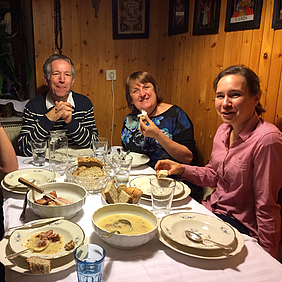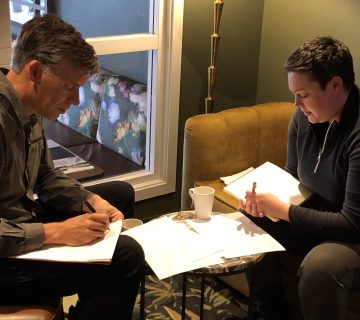Surrounded by beautiful Slovenian landscape and hosted by an extremely hospitable and generous couple, the inaugural workshop of the IE Natural Heritage Working Group took place with lots to discuss and to define.
How amazing! – Verena Perko and her husband, Andrej, opened their beautiful house to a bunch of people they almost did not know and prepared delicious local food, just to give the Interpret Europe natural heritage working group (IENHWG) a place to meet for the first time at the end of October.
Besides enjoying the hospitality and the food, the new working group had a lot of things to discuss. Well prepared by Peter Phillipson (Chair of the working group) and Susan Cross, the group had first to find a definition for natural heritage.
The wordsmith Susan smoothed the thoughts of the group with the following statement:
‘Natural heritage is not simply the rocks, plants and animals, rivers, seas and sky, it is what these things mean to us as Europeans, individually, nationally and globally.
Natural heritage covers the many and diverse connections – material, aesthetic, ecological, therapeutic, spiritual, scientific and others – between the human and non-human.
Natural heritage is about the values and meanings we recognise in the natural world and how that inspires us to safeguard them for the future.’
The group then posed, discussed and answered a number of other questions:
Why do we need Natural Heritage Interpretation?
People have lost knowledge and connection to their natural environment. This is where Heritage Interpretation comes in by creating meaningful experiences and reconnecting people with nature, which will lead ideally to a better understanding, appreciation and protection.
What makes Natural Heritage Interpretation distinctive?
Natural heritage interpretation (NHI) and environmental education (EE) share a number of characteristics to a greater or lesser extent. There is no hard division between them. It is better to think of them as a spectrum with NHI at one end and EE at the other. Although the middle of the spectrum contains areas of overlap, the ends of the spectrum are distinctively different.
Are Natural and Cultural Heritage completely different?
Heritage interpretation embraces both human and natural heritage. It integrates the two closely.
Interpret Europe must stand for the balanced integration of natural and human heritage.
However, IE has to communicate with organisations that work only on natural heritage. This needs a clear and separated view on topics related to nature.
What are the next steps?
- Among lots of ideas, the most important tasks are:
- Creating an IE rationale for natural heritage interpretation embedded into the Strategy and Management Plan
- Review, and where necessary strengthen, IE communications to ensure that there is an explicit, balanced and integrated approach to natural and cultural heritage
- Influence European policy in the fields of sustainable tourism, protected areas management and public health
- Create and support a Europe-wide community of natural heritage interpreters
Thanks to Peter Phillipson and Susan Cross for preparing and conducting the workshop. Thanks to Anna Saarela from Finland, Verena Perko and Marjeta Keršič Svetel from Slovenia, Eva Sandberg from Sweden, Nataliya Gudkova and Alena Tarasova from Ukraine for sharing all the ideas and knowledge.
Finally, again, a big thank you to Verena and Andrej for their extraordinary hospitality.
Markus Blank is a member of the Supervisory Committee of Interpret Europe. He works for the Gesäuse National Park in Austria in the department of environmental education and interpretation. You can get in touch with him at markus.blank@nationalpark.co.at.
To cite this article:
Blank, M. (2016) ‘Interpret Europe natural heritage working group’. In Interpret Europe Newsletter 4-2016, 5
Available online:
https://www.interpret-europe.net/fileadmin/Documents/publications/Newsletters/ie-newsletter_2016-4_winter.pdf




